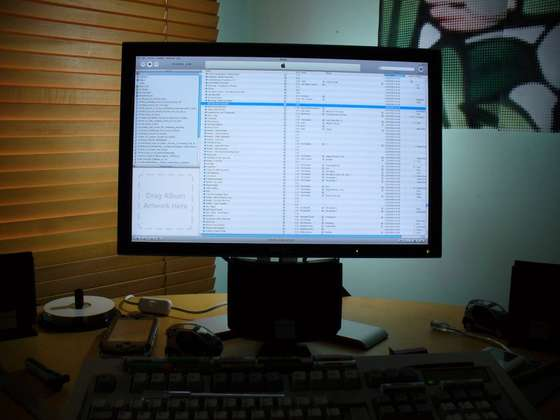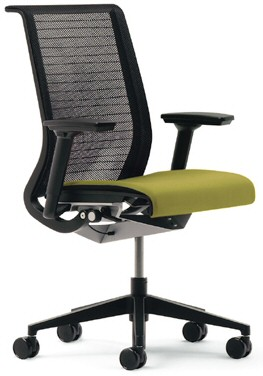Computer Workstation Ergonomics
I spend almost every waking moment in front of a computer. I’m what you might call an indoor enthusiast. I’ve been lucky not to experience any kind of computer-related injury due to my prolonged use of computers, but it is a very real professional risk. I get some occasional soreness in my hands or wrists, mostly after marathon binges where I’ve clearly overdone it – but that’s about the extent of it. All too many of my friends have struggled with long-term back pain or hand pain. While you can (and should) exercise your body and exercise your hands to strengthen them, there’s one part of this equation I’ve been ignoring.
I’ve been on a quest for the ultimate computer desk for a few years now, and I’ve talked at length about the value of investing in a great chair. But I hadn’t considered whether my current desk and chair is configured properly to fit my body. What about the ergonomics of my computer workstation?
The OSHA has an official page on computer workstation ergonomics, which is a good starting point. But like all government documents, there’s a lot more detail here than most people will ever need. The summary picture does give you an idea of what an ergonomic seating position looks like, though. How close is this to the way you’re sitting right now?
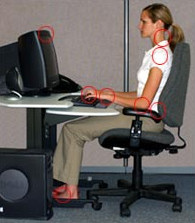
Microsoft doesn’t get enough credit for their often innovative hardware division, which first popularized ergonomic computer input devices, starting with the Microsoft Mouse 2.0 in 1993 and following with the Microsoft Natural Keyboard in 1994. With Microsoft’s long-standing interest in hardware ergonomics, perhaps it’s not too surprising to find that their healthy computing guide is one of the best and most succinct references for ergonomic computing I’ve found. But you don’t have to read it. I’ll summarize the key guidelines for computer workstation ergonomics here, distilling the best advice from all the sources I found.
I know I’ve harped on this, but it bears repeating: a quality desk and quality chair will be some of the best investments you’ll ever make as a software developer. They will last you for 10 years or more, and contribute directly to your work happiness every single day.
If you value your physical health, this is not an area you want to economize on. Hopefully you’ve invested in a decent computer desk and chair that provide the required adjustability to achieve an ergonomically correct computer workstation. Beyond the chair, you’ll need to potentially adjust the height of your desk and your monitor, too.
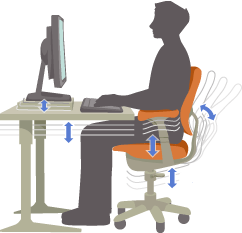
1. The top of your monitor should be at eye level, and directly centered in front of you. It should be about an arm’s length in front of you.
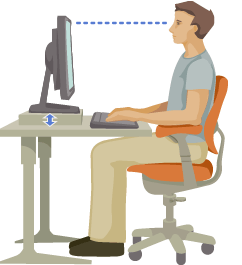
2. Your desk surface should be at roughly belly button level. When your arms are placed on the desk, your elbows should be at a ~90 degree angle, just below the desk surface. The armrests of your chair should be at nearly the same level as the desk surface to support your elbows.
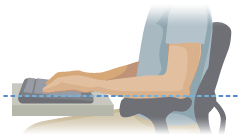
3. Your feet should be flat on the floor with your knees at a ~90 degree angle. Your seat should not be pressing into the back of your knees; if necessary, tilt it slightly forward to alleviate any knee pressure. Sit fully back in your chair, with your back and shoulders straight and supported by the back of the chair.
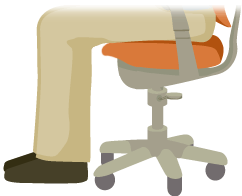
4. When typing, your wrists should be in line with your forearms and not bent up, down, or to the side. Your keyboard should be directly centered in front of you. Other frequently used items should be nearby, within arm’s reach.
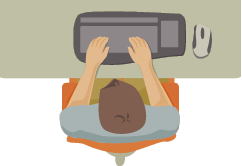
When it comes to computer workstation ergonomics, these are the most basic, most commonly repeated guidelines I saw. Ergonomics is a holistic discipline, not a science, so your results may vary. Still, I’m surprised how many of these very basic guidelines I’ve been breaking for so many years, without even thinking about it. I’ll be adjusting my home desk tomorrow in hopes of more comfortable computing.


